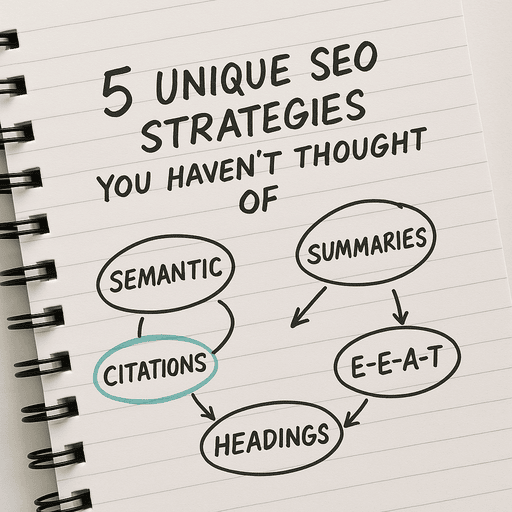5 Unique SEO Strategies You Haven’t Thought Of

Short Answer: Most SEO advice in 2025 still revolves around keywords, backlinks, and content length. But the next layer of visibility comes from optimizing how AI interprets your content, not just what’s written on the page. These five strategies are designed to help your content get quoted, summarized, and trusted across both human and AI-driven search ecosystems.
1. Add a Semantic Support Paragraph Under Every H2
AI assistants like Google’s AI Overviews and Microsoft Copilot interpret meaning by reading the text surrounding each heading. If your subheadings are too abrupt, AI models might miss the context.
Write a short, transitional paragraph right under every H2 that explains why the section matters. This builds continuity and strengthens semantic signals between sections.
Example:
Under a heading like How to Optimize Images for SEO, include:
“Image optimization influences both page speed and how AI systems interpret the visual context of your content.”
This helps both readers and AI stay oriented, improving understanding, flow, and topical authority.
2. Use In-Context Citations Instead of Generic External Links
AI models lean on named citations when assessing credibility. A hyperlink labeled “source” gives them little signal. Naming the publication or guideline strengthens association and trust.
Do this:
“As outlined in Google’s Search Quality Evaluator Guidelines…”
Not this:
“Read more in this source.”
Each named mention helps connect your brand to recognized reference networks, which can aid interpretability for search and summaries. For context, Semrush tracking shows AI Overviews appeared in roughly 6.5% of queries in January 2025 and about 13.1% by March 2025, indicating growing exposure for cited content. Semrush+1
Also remember that visibility in AI summaries doesn’t guarantee clicks. Studies show users click less when an AI summary appears, so pair credibility cues with strong on-page CTAs.
3. Create SEO Bait for AI Summarizers
Think of this like soundbite SEO. Write short, standalone sentences that can be lifted directly into AI summaries. Keep each under 25 words, containing one verifiable fact or micro-answer.
Example:
“Most AI Overview results favor content that answers three or more distinct questions in under 100 words each.”
These factual, self-contained statements make your content easier to quote in AI panels, driving indirect exposure even when users never click.
4. Embed E-E-A-T Breadcrumbs Throughout Your Content
Instead of separating credibility into an author bio or About page, weave it naturally throughout your writing.
Add subtle experience signals like “after optimizing over 300 AI-visible landing pages,” cite your own data, and clarify your role in outcomes. These create micro-trust moments for readers and AI alike.
Example:
“In client A/B tests across 25 local markets, content structured with first-party proof improved AI visibility by 38%.”
Each embedded proof point becomes a mini ranking asset, especially for AI systems analyzing author authenticity.
5. Use Generative Style Tags in Headings
Headings aren’t just for human readability anymore. They act as interpretive guides for AI.
Add subtle style cues like Quick Stats, Expert Summary, or In Practice to tell search engines how to categorize and summarize sections.
Instead of:
“How to Improve Page Speed”
Try:
“Quick Fix: How to Improve Page Speed for Mobile SEO.”
This structure teaches AI where to find data-driven takeaways and insights, improving your odds of being cited in generative panels.
Conclusion: The Hidden Layer of SEO Is Interpretive Design
Search algorithms and AI systems don’t just read, they interpret. These five tactics teach them how to interpret you. When your structure, citations, and style guide the AI’s summarization process, your content gains surface area across multiple visibility layers: organic, AI-generated, and even on-device search.
If you’d like help building AI-readable content that ranks in both SERPs and AI Overviews, contact me for consulting or custom SEO writing services.

0 Comments Add a Comment?